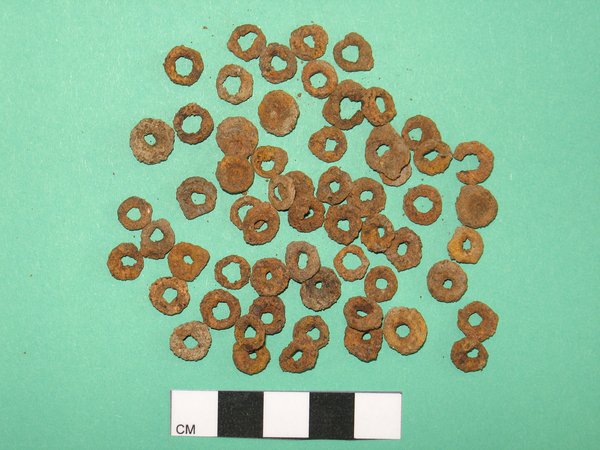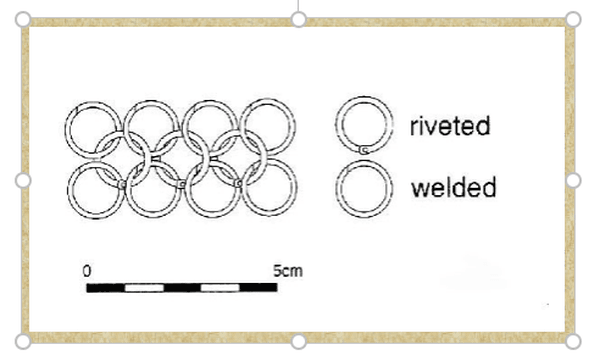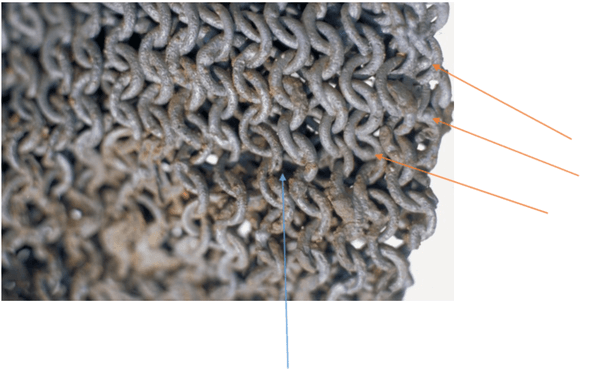Ring-mail Armour Loops activity
This activity is aimed at schools & families to help discover the wonder of Roman objects in our collection.
Ring-mail Armour Loops

These are a sample of loose loops from ring-mail armour, lorica hamata in Latin. Originally there had been over 175 loops, found together in one room in a second-century cavalry barrack at the fort. The loops are 7-8mm in diameter, and were presumably being used by a soldier to repair his armour.
Primary legionary and secondary auxilia troops would have worn these. Ring-mail armour could be made of iron or bronze rings and was in use from the Roman Republic to the Empire’s fall.
The unique pattern of these shirts, called 4 in 1, (see diagram and photos below) where metal rings are linked through four others, two in the row above it and two below provided excellent defence against slashing cuts and thrusts from the enemy, was very flexible and could be repaired easily when damaged by adding more loops. A standard lorica hamata had between 30,000 and 50,000 links, weighed around 11 kilos and could take up to three months to make depending on the design and materials used. Although the production was labour intensive, once made, they would last for years, and could be passed down to other soldiers.


Activities
Take a good look at the loops and the armour from our collection
What do you see, notice and wonder about them? How often do you think a soldier had to repair his armour? Do you think a soldier needed to be trained in how to make repairs? How do you think the soldier felt wearing ring-mail? Did you think he felt safe?
Now it’s your turn
Experiment with different materials you have around the house to make your own ring-mail clothing or objects. Try using strips of paper to make paper chains, figure out how to connect them to make a piece of armour you or your stuffed toys could wear. Next use card, or fabric or even hair bands. Which one is stronger, heavier, or more flexible? Now you’re ready to go into battle!
Learning extension
There were two types of soldiers that lived and worked at Arbeia. The first type were Legionary soldiers. They were responsible for the building of Arbeia, but were never garrisoned there. They lived on site only during the building over a period of 3 years. The other type of soldier was the Auxiliary soldier. They were garrisoned at the fort which meant they lived and defended it over a period of 300 years. Research the life of soldiers in Roman Britain. What were the living conditions like along the frontier of the Empire? How did they stay fit? What did they eat? where did they sleep? Did they have a daily routine? Imagine you are a soldier stationed at Arbeia. Are you a Legionary or Auxiliary soldier? Write an illustrated story about a typical day for you.
Make and share
Make and share your creations with us. Tag us on Twitter at @arbeiaromanfort, use the #Arbeiaathome hashtag, or post them on our Facebook page.
More online activities to enjoy
Unfortunately at this current time we can not offer our full family programmes in the museums but we have created lots of online learning activities for you to enjoy.
More online activities from our venues:
Segedunum Roman Fort
Find out about Marvellous Mondays : Home from Segedunum Collections.
South Shields Museum & Art Gallery
Take part in Take One Treasure Challenge - activities inspired by the museum collection.




